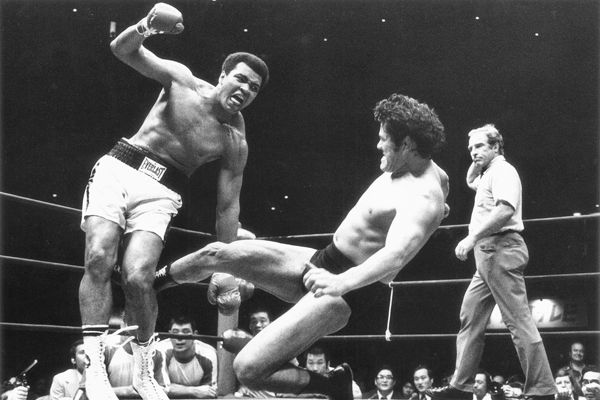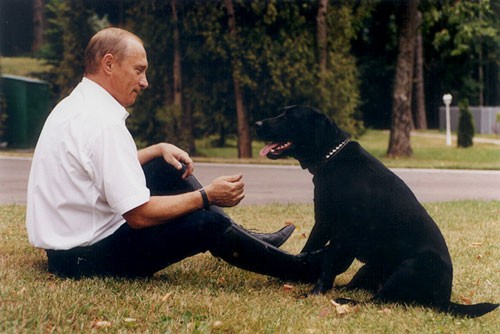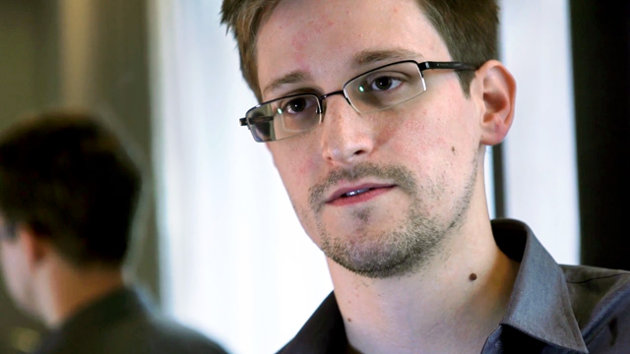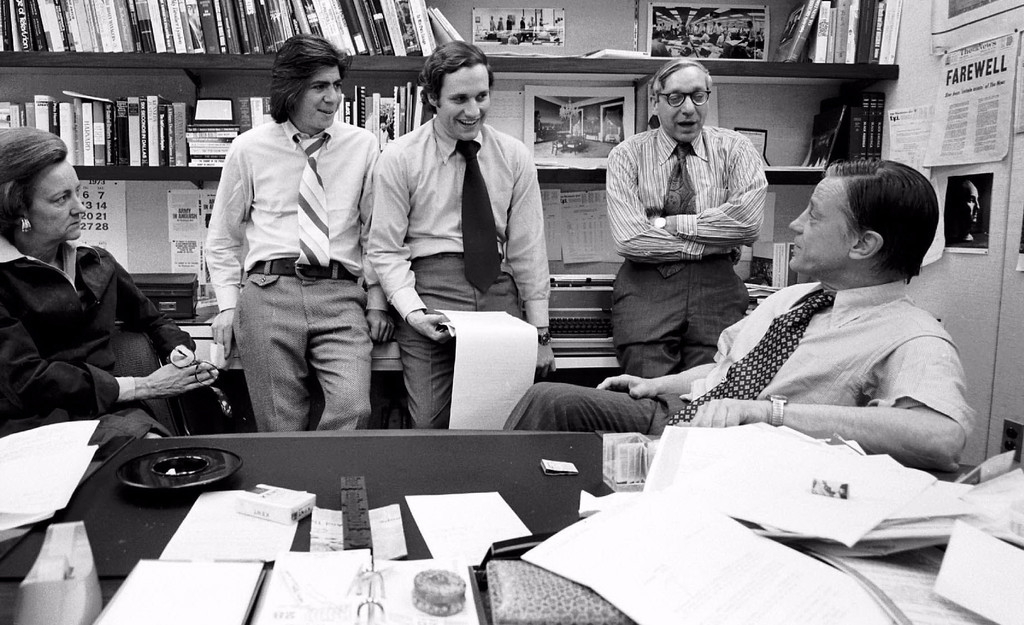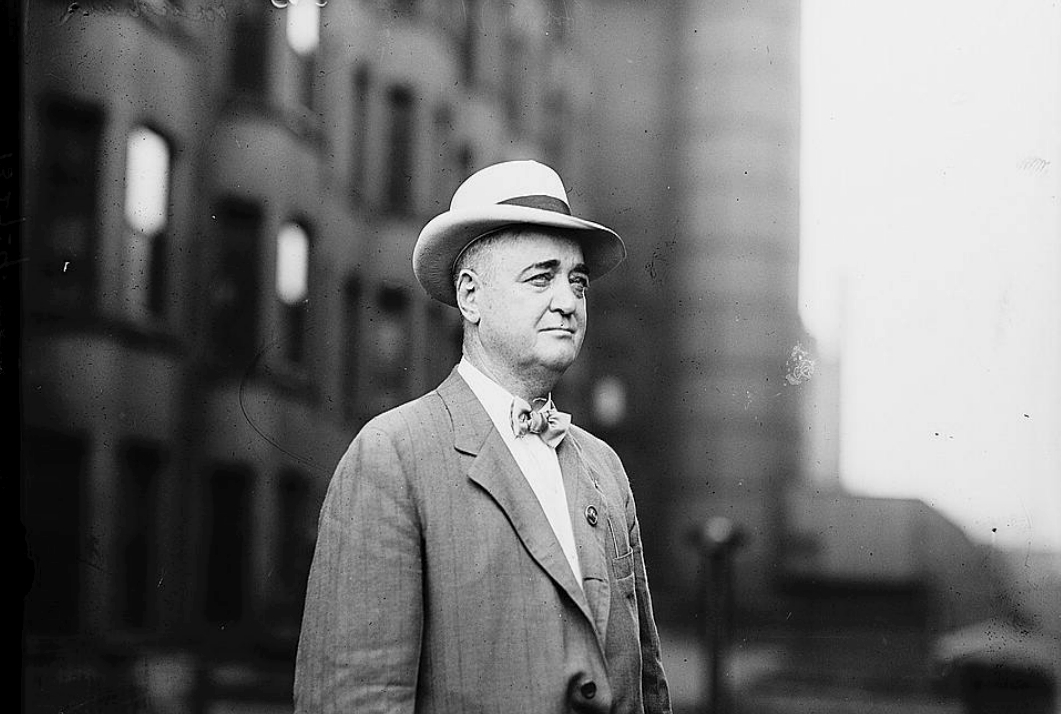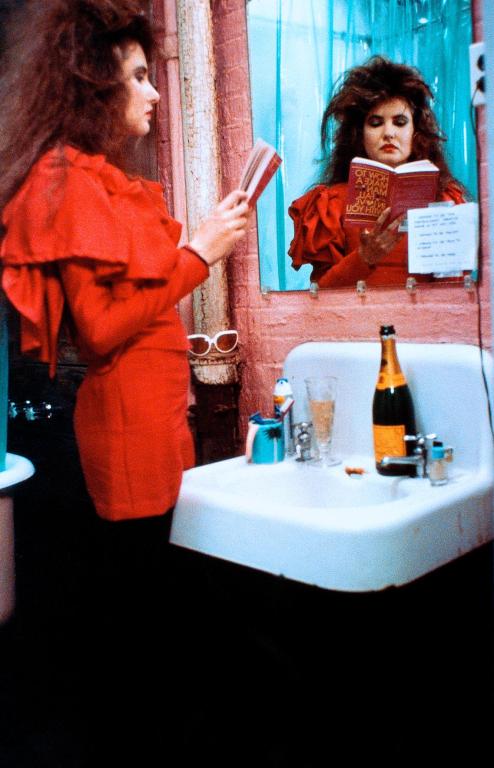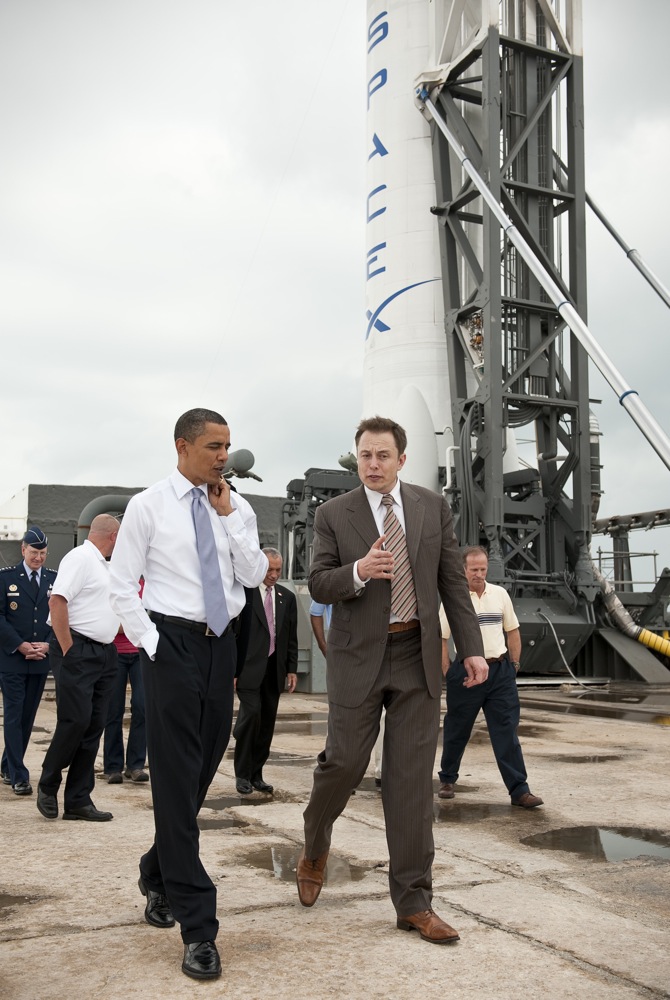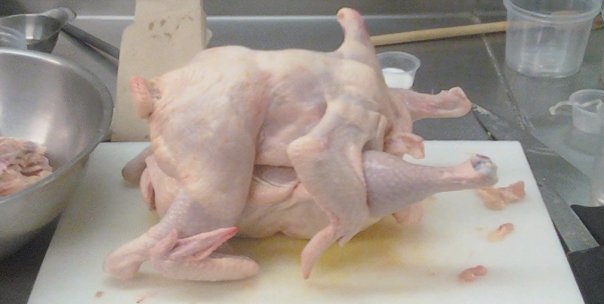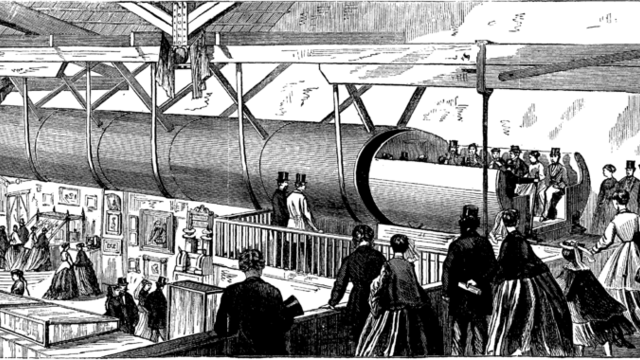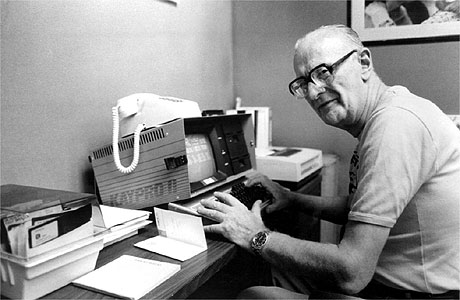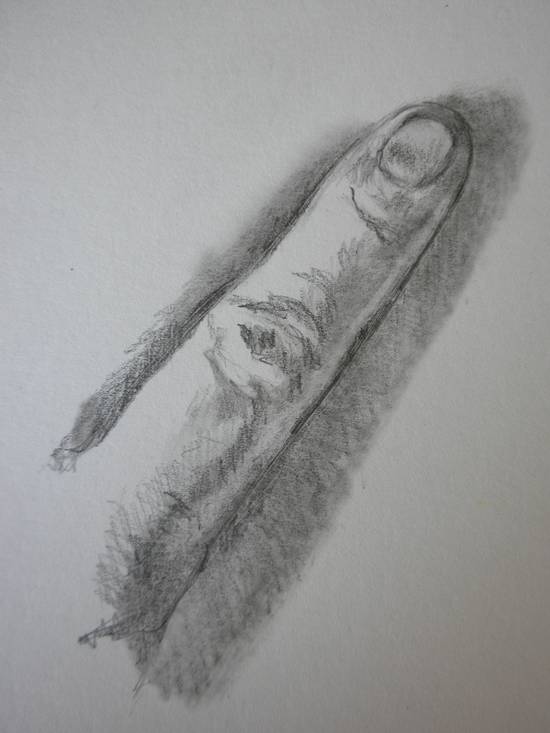The first ten minutes of a 20/20 profile of David Bowie from 1980, the year of his three-month run portraying David Merrick on Broadway in The Elephant Man. The late Metropolitan Museum director Thomas Hoving does the honors.
You are currently browsing the yearly archive for 2013.
Tags: David Bowie, David Merrick, Hugh Downs, Thomas Hoving
The opening of Seth Abramovitch’s Hollywood Reporter article about that town’s strange obsession with the Blackwing 602, a pencil that went out of production in 1998 and whose supply continues to dwindle:
“In the spring of 1960, Vladimir Nabokov was living in a rented villa in Los Angeles’ Mandeville Canyon, hard at work adapting his novel Lolita into a screenplay for Stanley Kubrick. He wrote in four-hour stretches, planted in a lawn chair ‘among the roses and mockingbirds,’ he later wrote, ‘using lined index cards and a Blackwing pencil for rubbing out and writing anew the scenes I had imagined in the morning.’ With more than 1,000 cards to work with, the scribe found that his pencil arguably became his most trusted collaborator.
Nabokov isn’t alone in his devotion to the Blackwing 602, without question among the most fetishized writing instruments of all time. It counts among its cultish fan base some of the greatest creative geniuses of the 20th century, from John Steinbeck (‘I have found a new kind of pencil — the best I have ever had!’ he wrote) to Quincy Jones (the Thriller producer says he carries one under his sweater when making ‘continual fixes’ to his music) and Truman Capote (who stocked his nightstands with fresh boxes) to Stephen Sondheim, who has composed exclusively with Blackwings since the early 1960s.
The pencil even made its way onto television’s most object-obsessive series, AMC’s Mad Men, put there by TV director Tim Hunter, who says, ‘I just had always felt that these folks would be using Blackwings.’ Animators, including artists who drew such iconic characters as Bugs Bunny and Mickey Mouse, remain its most die-hard devotees — and earliest hoarders: The Blackwing 602 is becoming increasingly rare as it fast approaches its 80th birthday, with ostensibly only a few thousand in existence among the 13,000 that comprised its last lot in 1998, when the line was phased out.”
Tags: John Steinbeck, Quincy Jones, Seth Abramovitch, Stanley Kubrick, Stephen Sondheim, Truman Capote, Vladimir Nabokov
When Muhammad Ali was asked where he got his great and playfully arrogant interview skills, he frequently credited seeing a clip of Gorgeous George, the wrestler who gained national fame in he 1950s as a narcissistic TV presence. Years later, it’s said that Ali realized that the one who had actually influenced him was another blonde grappler, Freddie Blassie. He had gotten them confused. In this 1976 clip, Tonight Show guest host McLean Stevenson and Ed McMahon welcome Ali and Blassie as the two hyped a mixed boxing-wrestling match featuring the Greatest versus Japanese wrestler Antonio Inoki.
Postscript: In 1990, Inoki, who had entered politics the year prior, was sent to Iraq to negotiate with Saddam Hussein for the release of Japanese hostages. Inoki secured their passage and converted to Islam later that year (Muslim name: Muhammad Hussain). He’s since had a contentious career in politics, even being elected to a seat in Japan’s Upper House.
Tags: Antonio Inoki, Ed McMahon, McLean Stevenson, Muhammad Ali, Saddam Hussein
From the May 30, 1901 New York Times:
“Mrs. Mary Himmerich, twenty-two years old, the wife of John Himmerich, a musician, living at 182 Meserole Street, Williamsburg, died on Tuesday from erysipelas as a result of a scratch on the cheek received a week ago from the finger nails of her seven-months-old baby.
At the time Mrs. Himmerich paid little attention to the scratch, but two days later her face began to swell, and she then went to a dispensary. Failing to get relief, and the pain increasing, she called in Dr. Bookbinder of 1,250 Madison Street. The doctor found she had erysipelas as a result of the scratch. Mrs. Himmerich died in great agony on Tuesday.”
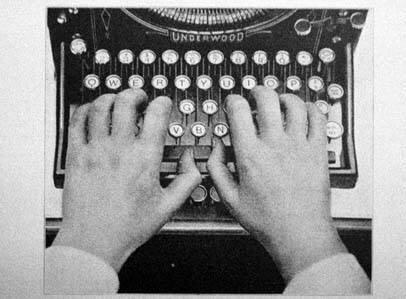
10 search-engine keyphrases bringing traffic to Afflictor this week:
- steve mcqueen michael fassbender shame
- hillary clinton on the arsenio hall show in 1992
- information about willie mosconi’s childhood
- lunacy commission old new york
- gore vidal criticizing thomas pynchon
- video of telly savalas singing to big head
- was cricket ever popular in america?
- brian mckinnon pretended to be a teenager
- does any schumer use cocaine?
- nicholas de monchaux apollo spacesuits
- Old Print Articles: Nikola Tesla discusses his military-drone system (1915) + Mother sells index finger to pay for daughter’s music lessons (1911).
- Classic Photograph: Western icon Bat Masterson dies a New York sportswriter.
- Recently Posted on NYC’s Craigslist: Anthony Weiner on the campaign trail + My family is like a boxcar full of hobos + It’s also tax-deductible.
- Featured Videos: Elon Musk at the Teslive town hall + Two Mel Brooks clips (1975/2013).
- The Hyperloop may be a modern version of pneumatic tubes.
- Tama Janowitz was a literary star when money became crazy in NYC.
- Bill Simmons, Malcolm Gladwell and Nate Silver discuss the WaPo sale.
- Paul Schrader does an Ask Me Anything at Reddit.
- The tool we use to watch movies influences our choices.
- Multimedia multitaskers could use their own movie theaters.
- In 1995, as the Internet took off, Arthur C. Clarke was interviewed.
- Bill Gates mocks the ventures of fellow technologists.
- E-book sales have flattened in the U.S., declined globally.
- Brad Templeton thinks robocars should be able to break the speed limit.
- Matthew Brady and other photographers had marketing tricks.
- Mike Gimbel is an unsung hero of the Moneyball era.
- Steven Pinker doesn’t think science is the enemy of humanities.
- Tyler Cowen is thus far unimpressed with Amazon’s art dealing.
- Rob Rhinehart is still drinking Soylent.
- With a few hundred dollars, you can do some major spying.
- Neuropathic computing may have a profound effect on society.
- Some people admit to crimes they haven’t committed.
- A brief note from 1904 about a girl with followers.
- A brief note from 1922 about a sane man.
- This week’s Afflictor keyphrase searches.
Although I don’t think Amazon’s entry into the art market can make that scene any more ridiculous than it already is, economist Tyler Cowen writes disapprovingly of the early returns in a Marginal Revolution post. An excerpt:
“I expect the real business here to come in posters, lower quality lithographs, and screen prints, not fine art per se. And sold on a commodity basis. There is nothing wrong with that, but I don’t think it will amount to much more aesthetic importance than say Amazon selling tennis balls or lawnmowers.
Should you buy this mediocre Mary Cassatt lithograph for ‘Price: $185,000.00 + $4.49 shipping’? (Jeff, is WaPo charging you $250 million plus $4.49 shipping? I don’t think so. )
One enduring feature of the art world is that a given piece will sell for much more in one context rather than another. The same painting that might sell for 5k from a lower tier dealer won’t command more than 2k on eBay, if that. Yet it could sell for 10k, as a bargain item, relatively speaking, if it ended up in the right NYC gallery (which it probably wouldn’t). Where does Amazon stand in this hierarchy? It doesn’t look promising.
Their Warhols are weak and overpriced, even if you like Warhol. Are they so sure that this rather grisly Monet is actually the real thing? I say the reviews of that item gets it right. At least the shipping is free and you can leave feedback.
I’ve browsed the ‘above 10k’ category and virtually all of it seems a) aesthetically abysmal and b) drastically overpriced. It looks like dealers trying to unload unwanted, hard to sell inventory at sucker prices. I’m guessing that many of these are being sold at multiples of three or four over auction price histories.”
Tags: Tyler Cowen
From “Robocars and the Speed Limit,” Brad Templeton’s essay about why he thinks we should allow autonomous vehicles to speed:
“The limit is a number, but it is not especially magic. It’s not like one is safe at 65mph and reckless at 66mph, even though that’s how the law is written. Rather the risk from accidents increases gradually with speed. The risk of having an accident is harder to measure, but the severity of an accident is related to the square of the speed of impact.
There is a speed at which we may judge the accident risk is above acceptable limits. This speed is not a single number. It varies from driver to driver, and from car to car. It varies from hour to hour, from weather condition to weather condition and from road to road. As the Autobahn’s lower accident rate shows, some drivers are safer at very high speeds on well designed roads than other drivers are at 50mph on lesser roads.
And while the Germans are content to do it, the USA is not prepared to officially let drivers decide what the right speed for acceptable safety is. Rather it is done unofficially and irregularly.
How does a robocar enter this world? There are two common schools of thought:
- As with its ancestor, the cruise control, the operator of a robocar can set the car to operate at any speed within its general limits, regardless of the road speed limit. The moral and safety decisions rest with this person.
- The vehicle must be programmed to not break the speed limit, nor allow its operator to do so. It must be aware of all limits and obey them.
I believe the first choice is both better and more likely.”
Tags: Brad Templeton
Really good new B.S. Report with Bill Simmons welcoming Nate Silver and Malcolm Gladwell to discuss newspapers in the age of the Internet and the Graham family selling the Washington Post to Jeff Bezos, among other topics. Some interesting moments:
- Gladwell on the New Yorker in the Digital Age: “We’re one of the winners of this revolution.” He points out something that doesn’t get said very often: Because the print version of the magazine goes online at the same time all over the world, it’s opened more of a global market. Of course, the same is true of the Times, which hasn’t benefited as much. But the New Yorker has a smaller cast of talent to support and we live more in a niche, boutique age with bigger but fewer global blockbusters. Also: The New Yorker was never given away for free on any platform for any period of its existence.
- I don’t know if I agree with Gladwell’s take (expressed in the headline) that newspapers need to have polymaths, free of specific beats, who are writing on any number of topics. In such a deadline-driven environment, that may lead to superficial knowledge and armchair journalism. (Gladwell, a proud polymath himself, has been accused of such things.) And does such a wide-ranging talent pool really exist? Could it supply hundreds of such reporters to the Times and the same amount to, say, a quartet of other national newspapers? He may be right in theory–news dissemination should resemble more closely the mash-up machinery that disseminates it–but I wonder if his idea could be applied in a practical sense.
- My take on Silver’s feeling about the New York Times after listening to this podcast: He speaks of the place respectfully, but feels it isn’t nearly bold enough in reinventing itself, which was one of the main reasons he departed for ESPN, a company with oodles of money to invest in a dynamic online presence. He also questions the business acumen of the Times: “With all the traffic the New York Times is getting right now, I feel like it should be making a much higher profit.”
Listen here.
Tags: Bill Simmons, Malcolm Gladwell, Nate Silver
No one has ever come up with a bigger lie than F. Scott’s Fitzgerald with this whopper: “There are no second acts in American lives.” There have always been second acts and many more after that. I mean, not if you drink yourself to death, but for anyone who waits out the bad times with good humor.
Bat Masterson was many things in his sixty-seven years–buffalo hunter, Army scout, sheriff, gambler and boxing manager, etc.–until he was one final thing: a New York City newspaper sportswriter. He died as an ink-stained wretch at an editor’s desk, not a gunslinger in a saloon. Masterson is in his journalistic dotage in the above undated classic photo. The report of his death from the October 26, 1921 New York Times:
“William Barclay Masterson, better known as Bat Masterson, sporting writer, friend of Theodore Roosevelt and former sheriff of Dodge City, Kan., died suddenly yesterday while writing an article at his desk in the office of the The Morning Telegraph. He had been connected with the paper for more than ten years, and for the last few years had been one of its editors.
At one time Masterson was said to have been the best known man between the Mississippi and the Pacific Coast, and his exploits and his ability as a gun fighter have become part of the tradition of the Middle West of many years ago. He was the last of the old time gun fighters.
He was born in Iriquios County, Ill., in 1854, the son of a farmer who came originally from St. Lawrence County, N.Y. Little more than a boy, Bat, his rifle across his knees, left the farm and rode into the then Fort Dodge and joined a party of buffalo hunters. Then his actual career began, and probably more weird and bloodthirsty tales have been written about him than of nearly any other man. His fights, however, were in the cause of justice, and he was one of a group of gunfighters who made that part of the country unhealthy for the bad men of the period.
While in the frontier town Bat heard one day that his brother had been killed across the street. Bat headed over. What happened he thus told later on the witness stand:
‘The cowboys had been on the range for some time and were drinking. My brother was the Town Marshall. They were carrying six-shooters and he attempted to disarm one of them who was particularly mean. They shot and killed him and they attempted to kill me. I shot and killed them–one at any rate–and shot the other one.’
His second killing was a cowboy named Jim Kennedy, who had come to town seeking the life of the Mayor. Kennedy shot several times through the door of a Mayor’s house and killed a woman. Then Masterson started out to get him. And he did.
One of Masterson’s most famous exploits was the battle of Dobe Walls, when with nine companions he stood off 200 Indians in a siege of 29 days. The attacking force was composed of Arapahoes and Cheyennes. A fortunate accident–the fall of part of the dirt roof of a saloon in which the buffalo hunters were sleeping–prevented the party from being surprised by the Indians and murdered in their sleep, for the attack was not anticipated. In the gray light of a June morning, when the hunters were engaged in restoring the roof, the Indians descended upon them. The hunters abandoned the roof and took to their guns. Time after time the Indian attack was stopped and the enemy driven back to the shelter of a fringe of cottonwoods along the Canadian River.
Masterson was only 18 years old when he joined Lieutenant Baldwin’s civilian scouts under Colonel Nelson A. Miles. He participated in the battle of Red River, where the Indians were commanded by Geronimo, and in other Indian engagements. Masterson lived fifteen years in Denver. There he became interested in pugilism. He went broke backing Charlie Mitchell in his fight with James J. Corbett. He was an official in the fight between Fitzsimmons and Corbett.”
________________________________
Masterson officiating Fitzsimmons-Corbett in 1897:
Tags: Bat Masterson, Bob Fitzsimmons, Charlie Mitchell, Colonel Nelson A. Miles, Geronimo, James J. Corbett, Jim Kennedy, Lieutenant Baldwin
The sales of e-books have flattened this year in the U.S., and even declined worldwide, surprisingly. An excerpt from Nicholas Carr’s list of six reasons why this might be so:
“1. We may be discovering that e-books are well suited to some types of books (like genre fiction) but not well suited to other types (like nonfiction and literary fiction) and are well suited to certain reading situations (plane trips) but less well suited to others (lying on the couch at home). The e-book may turn out to be more a complement to the printed book, as audiobooks have long been, rather than an outright substitute.
2. The early adopters, who tend also to be the enthusiastic adopters, have already made their move to e-books. Further converts will be harder to come by, particularly given the fact that 59 percent of American book readers say they have ‘no interest’ in e-books, according to the Bowker report.
3. The advantages of printed books have been underrated, while the advantages of e-books have been overrated.”
Tags: Nicholas Carr
New York City has always been a gold rush but one that usually created something beautiful or exciting in the pursuit. I’m not sure that’s true anymore. When people reflexively refer to it as the “greatest city in the world,” I wince. It’s still interesting, sure, but Manhattan is now primarily the playground of the wealthy and tourists. And the things New York did that made it special, the media and such, have been diminished, dispersed and democratized by technology. You’re still special to me, New York, but we’re growing apart.
Maybe too many of the really creative people I know have dispatched to the West Coast and other points or perhaps these are the dark thoughts one has when hastily crossing the street in Soho on a Tuesday night to avoid a horde of middle-school girls in Daisy Dukes who frantically await a Kardashian poster-signing.
The opening of Dinah Prince’s 1986 New York magazine cover story on Tama Janowitz, written at a time when New York decided that money could buy it happiness but when literature still had a place in the discussion:
“On the day before her party at the Milkbar, Tama Janowitz was in a panic. Lisa E. who had organized the affair to celebrate Janowitz’s new book of short stories, Slaves of New York, called to say she had just bought a new dress. It was long and blue and had big sexy cutouts beneath each breast.
‘I was like, ‘She’s got a new dress?!‘ Janowitz recalls. I really wanted one.’
After Janowitz hung up, the 29-year-old author tried to tell herself she would be perfectly presentable. She could wear her black velvet miniskirt and the sequined top an ex-boyfriend had got her from fashion designer Stephen Sprouse in exchange for a painting.
‘It was cute; I mean, it would have been fine,’ she says.
Janowitz’s newest beau, a Texas oilman named Brady Oman, was in town for the party. When he heard about Lisa E.’s dress, he took Janowitz shopping in the East Village and SoHo.
‘We ran all over looking for dresses,’ Janowitz says. ‘He took me into IF, and, I mean, they were really pretty. But $1,500 for some froufrou thing?’
Two hours before the party, Janowitz called Paige Powell, an advertising associate at Interview.
‘Paige, I have nothing to wear!’ she said.
Powell met the writer and her new boyfriend at Texarkana with an armload of dresses. In the ladies’ room, Janowitz modeled a scarlet dress with one bare shoulder and a tutu that billowed from her hip.
She walked out in the dress, and it met with the approval of everyone in the restaurant,’ Powell says.
After finishing her steak, Janowitz headed to the party.
‘Oh God, I tried to be nervous and thought, Well, I’ll just pretend it’s a party for somebody else,’ she says. She descended the red neon-bathed staircase into the Milkbar and instantly became the center of attention. She was photographed by Newsweek, Details, and NY Talk. Patrick McMullan, a downtown paparazzo, posed her beside comedian Howie Mandel.
‘I was like, I didn’t know who the person was,’ she says. ‘Some geek who obviously didn’t know who I was and didn’t care to know who I was. But there he was, getting his picture taken with me. I said to him, ‘Howie, I’m waiting for my left breast to fall out of my dress.’ He was totally uninterested.’
Back in her tiny Horatio Street studio apartment by 2 A.M., Janowitz and Oman folded out the couch and went to bed. A few hours later, the shower curtain collapsed in the bathroom. This set off a series of ear-piercing howls from her Yorkshire terriers, Lulu and Beep-beep. Finally, after everyone got back to sleep, the phone rang at 6 A.M.
‘Some guy called looking for his boyfriend,’ she says, ‘thinking I had run off with his boyfriend.’
Such is the stuff of Tama Janowitz’s life.”
Tags: Brady Oman, Dinah Prince, Howie Mandel, Lisa E., Paige Powell, Patrick McMullan, Stephen Sprouse, Tama Janowitz
Monica Heisey of Vice has an update on an earlier story about Rob Rhinehart, who began living on a meal-replacement drink of his own making about seven months ago. Despite receiving massive criticism from nutritionists and foodies, he says his health has been good and now he’s incorporated. From the piece:
“Vice:
A lot of people got mad when you claimed Soylent was as nutritious as fruit or vegetables.
Rob Rhinehart:
Just because something is natural doesn’t mean it’s safe or healthy, and just because something is artificial doesn’t mean it’s unhealthy or dangerous. Look around you. Nothing we buy is natural. Everything useful is designed and manufactured, and food should be no different. People are afraid of sweeteners when it’s real sugar that’s killing us. They’re afraid of preservatives when food waste is rampant. McDonald’s is trying to engineer lower-calorie food that is more filling to fight obesity, but people are demanding natural-sounding ingredients. It’s frustrating to watch. The idea of ‘real food’ is just snobbery. Everyone has the right to be healthy, even people who don’t like vegetables.
Vice:
If it’s all completely approved why do you think people are still afraid of it?
Rob Rhinehart:
Fear makes a better story—fear-mongering in food is too easy for many media outlets and entertainers to resist. Part of the reason I created Soylent was to avoid the cacophony of opinions and misinformation around food and diet. I’m certainly taking less of a risk now than I was with a diet known to be unhealthy. People fear what they don’t understand. By being transparent and clear we will continue to bring more people around to this important idea.
Vice:
Nutritionists, foodies, and other critics seemed particularly attached to the idea of chewing, and are mad at you for taking it away. Are you dedicated to the smoothie medium or could Soylent move into bars and cereals and other solid foods?
Rob Rhinehart:
We can make anything, but a liquid is the best for nutrient absorption. Humans started chewing in the first place because it makes food closer to a liquid.”
Tags: Monica Heisey, Rob Rhinehart
Two exchanges from the new Bill Gates interview in Businessweek in which he criticizes, unfairly I think, the high-tech endeavors of Brin & Page, Bezos and Musk.
____________________
Question:
There are other successful businessmen who are orienting their extracurricular interests around space exploration. Is that interesting to you? Is that worthwhile for humanity?
Bill Gates:
Everybody’s got their own priorities. In terms of improving the state of humanity, I don’t see the direct connection. I guess it’s fun, because you shoot rockets up in the air. But it’s not an area that I’ll be putting money into.
____________________
Question:
One of Google’s convictions is that bringing Internet connectivity to less-developed countries can lead to all sorts of secondary benefits. It has a project to float broadband transmitters on balloons. Can bringing Internet access to parts of the world that don’t have it help solve problems?
Bill Gates:
When you’re dying of malaria, I suppose you’ll look up and see that balloon, and I’m not sure how it’ll help you. When a kid gets diarrhea, no, there’s no website that relieves that. Certainly I’m a huge believer in the digital revolution. And connecting up primary-health-care centers, connecting up schools, those are good things. But no, those are not, for the really low-income countries, unless you directly say we’re going to do something about malaria.
Google started out saying they were going to do a broad set of things. They hired Larry Brilliant, and they got fantastic publicity. And then they shut it all down. Now they’re just doing their core thing. Fine. But the actors who just do their core thing are not going to uplift the poor.
Tags: Bill Gates
From the October 9, 1904 New York Times.
“Berlin–The attention of the police of the little town of Annaberg, Saxony, has recently been directed to a very remarkable sect. Its main characteristic consists in the adoration of a young girl, who professes the gift of speaking in various tongues. She has declared herself to be the veritable Christ, and the members of the sect say the Saviour has reappeared in the form of this girl. The devotees hold regular meetings on the Poehlberg, a hill in the environs of Annaberg.
A strange night awaited the police when they came to this place of worship. They found assembled a large concourse of people, kneeling before the girl, who was resting on a green cushion. When the police removed the girl in order to take her to a hospital, the fanatical worshippers made the most tumultuous opposition. Soon afterward, however, the girl was allowed to leave the hospital, as nothing abnormal in her condition could be discovered.”
We shape our tools, and thereafter our tools shape us. A passage from Tom Vanderbilt’s smart Wired interview with Netflix’s recommendations honchos Carlos Gomez-Uribe and Xavier Amatriain:
“Question:
So if I’m viewing on my iPad at midnight, do I see different recommendations than I would on my TV at 8 pm?
Xavier Amatriain:
We have been working for some time on introducing context into recommendations. We have data that suggests there is different viewing behavior depending on the day of the week, the time of day, the device, and sometimes even the location. But implementing contextual recommendations has practical challenges that we are currently working on. We hope to be using it in the near future.”
Steven Pinker, who is not a douchebag despite what some people say, has published “Science Is Not Your Enemy,” an article for the New Republic. From a passage about the most recent collision of the Two Cultures:
“The humanities are the domain in which the intrusion of science has produced the strongest recoil. Yet it is just that domain that would seem to be most in need of an infusion of new ideas. By most accounts, the humanities are in trouble. University programs are downsizing, the next generation of scholars is un- or underemployed, morale is sinking, students are staying away in droves. No thinking person should be indifferent to our society’s disinvestment from the humanities, which are indispensable to a civilized democracy.
Diagnoses of the malaise of the humanities rightly point to anti-intellectual trends in our culture and to the commercialization of our universities. But an honest appraisal would have to acknowledge that some of the damage is self-inflicted. The humanities have yet to recover from the disaster of postmodernism, with its defiant obscurantism, dogmatic relativism, and suffocating political correctness. And they have failed to define a progressive agenda. Several university presidents and provosts have lamented to me that when a scientist comes into their office, it’s to announce some exciting new research opportunity and demand the resources to pursue it. When a humanities scholar drops by, it’s to plead for respect for the way things have always been done.
Those ways do deserve respect, and there can be no replacement for the varieties of close reading, thick description, and deep immersion that erudite scholars can apply to individual works. But must these be the only paths to understanding? A consilience with science offers the humanities countless possibilities for innovation in understanding. Art, culture, and society are products of human brains. They originate in our faculties of perception, thought, and emotion, and they cumulate and spread through the epidemiological dynamics by which one person affects others. Shouldn’t we be curious to understand these connections? Both sides would win. The humanities would enjoy more of the explanatory depth of the sciences, to say nothing of the kind of a progressive agenda that appeals to deans and donors. The sciences could challenge their theories with the natural experiments and ecologically valid phenomena that have been so richly characterized by humanists.
In some disciplines, this consilience is a fait accompli. Archeology has grown from a branch of art history to a high-tech science. Linguistics and the philosophy of mind shade into cognitive science and neuroscience.
Similar opportunities are there for the exploring.”
At Motherboard, John Gardi guesses at the nature of Elon Musk’s Hyperloop, a guess which the Tesla Motors chief says is the best one he’s seen. An excerpt:
“I believe that Hyperloop is merely a modern day version of the pneumatic tubes used in banks, stores, and industry to move money and small items over long distances or to other floors of a building. They’ve been around for over a century, though not so much these days. There is only one in my town that I know of, and it has fallen into disuse. One reason I think Hyperloop is simpler than folks think is that Elon Musk has resurrected another technology from the depths of time, one that was a contender once, too: the electric car!
The main focus of this document will be to show how we might accomplish Elon Musk’s claim that his Hyperloop concept could be built for a 10th of the cost of California’s proposed high speed rail. Using technology no more complicated than warehouse building, I’ll discuss how the Hyperloop’s main line between Los Angeles and San Francisco might be constructed well within Musk’s estimates.
I’ll describe an overall design as well as construction techniques—since the main line will comprise the bulk of Hyperloop’s hardware, this will be where cost reduction matters the most.
With what clues we all know now, I do believe I can make a pretty good (self) educated guess about how Hyperloop’s main line could be built and why it could be done cost effectively. There’s a lot we can extrapolate without having to augur down into the nuts and bolts of Hyperloop’s specific technologies.
I’ll leave that part to Elon Musk himself on August 12th.”
Tags: Elon Musk, John Gardi
In 1995, just as the Internet began entering the public consciousness with a fury, Tod Mesirow interviewed Arthur C. Clarke. Part of that discussion has now been posted at the Los Angeles Review of Books. An excerpt about 2001: A Space Odyssey:
“Tod Mesirow:
The idea of an intelligent computer, an artificial intelligence like HAL, do you think we’ll achieve that?
Arthur C. Clarke:
Oh, I don’t think there’s any question of that. I think that the people that say we will never develop computer intelligence — they merely prove that some biological systems don’t have much intelligence.
Tod Mesirow:
What was it like to create the scene when HAL is dying in 2001?
Arthur C. Clarke:
Well, Danny Curry deserves most of the credit for that, and by the way, when I switch off my computer you hear HAL say, “My mind is going.” It happens every time I switch it off. [laughs]
Tod Mesirow:
Was 2001 an interesting experience? You’re planning what would happen if —
Arthur C. Clarke:
Well, it was, you know, a fascinating experience, for many reasons. I was moonlighting at Time Life where I was doing a book called Man and Space. This was in 1964 when the Apollo Program, you know, had been announced. But, no one really believed we would go to the moon and, still sort of had a skepticism. And also, Stanley and I had to outguess what would happen, I believe — this may not be true, maybe Stanley’s publicity department — he’s supposed to have gone to Lloyd’s, taken an insurance against Martians being discovered before the film was released. [laughs] Well, I don’t think — I don’t know how Lloyd’s would have carried the odds on that one. [laughs] So, anyway, we were writing the film, before we had any close-ups of the moon’s surface. We had to guess what it might be like, and there are all sorts of problems. I — we — I think we did pretty well. One or two mistakes. For instance, we show the moon as more rugged then in fact it turned out to be. It turned out to be sort of smooth and sort of sandblasted.”
Bedbug Success Stories
Can someone tell me how to get rid of bedbugs on their own !!! I got a used dresser, night stands, and a hope chest that is at the foot of the bed. Then about 6 months later my husband felt something on his foot, he used the flashlight in his cell phone to look in sheets. THERE MUST HAVE BEEN 200 OF THEM ALL OVER THE BED !!!! We threw everything outside at like 2am then burned it later that day.
Too late – they were in every room (couches, and the beds of my 3 young children) !!! HELP !!!!
Doesn’t 1911 sound awfully early for a finger transplant? Well, that’s the basis of a grisly article in the August 6 New York Times of that year about a woman of modest means who offered to sell her index finger to a rich one who lost hers to amputation. The story:
“Chicago–Mrs. Minnie O’Herrin says she will gladly sacrifice the index finger on her right hand in order to give her six-year-old daughter Isla a musical education.
Mrs. Reginald Waldorf of Philadelphia recently injured the index finger on the right hand by a cut from a rusty nail. Blood poisoning resulted, and the finger was amputated. ‘There is but one thing that can restore your hand to its former condition,’ said the surgeon who amputated the digit. ‘Some other woman whose finger will fit and who is willing to sell her finger must be found. The new finger can be amputated and grafted on.’
An advertisement was published in the Philadelphia papers, inviting proposals for a finger. Mrs. O’Herrin saw the advertisement, and yesterday wrote that she would make the sacrifice.”
Tags: Isla O'Herrin, Mrs. Minnie O'Herrin, Mrs. Reginald Waldorf



